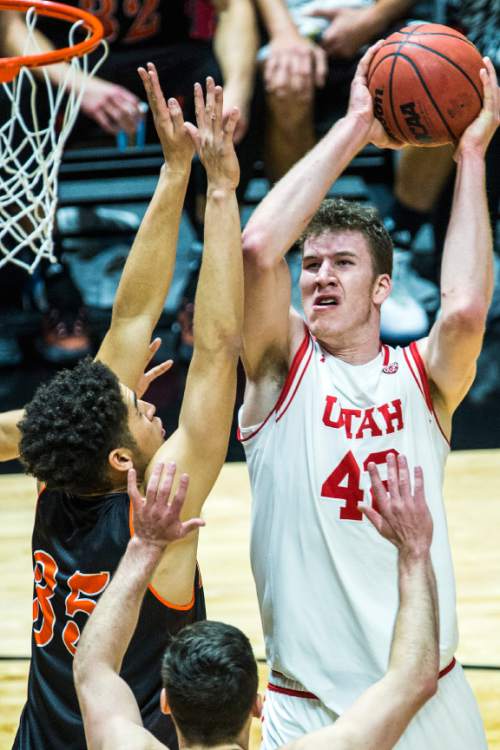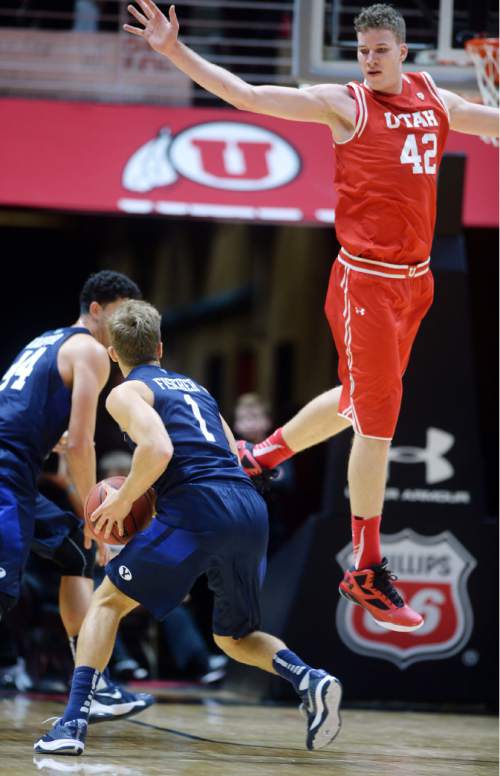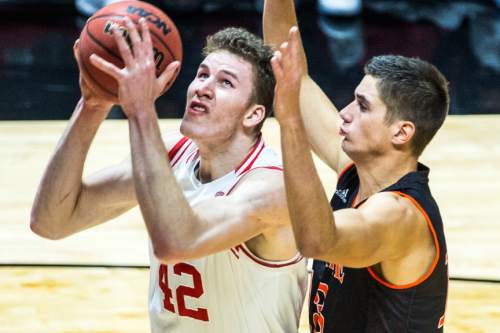This is an archived article that was published on sltrib.com in 2015, and information in the article may be outdated. It is provided only for personal research purposes and may not be reprinted.
Salt Lake City • Team A shot 53 percent with eight 3-pointers and 10 assists against three turnovers. Team B shot 35 percent with one 3-pointer and four assists to 10 turnovers.
Which team is better? Trick question: It's two halves of Utah on Wednesday night against BYU.
Fans who are just tuning into basketball season got a taste of the hot-and-cold flow of the early-season Runnin' Utes. In the first half, they were dominant, running BYU off the Huntsman Center floor with staunch defense and seemingly effortless ball movement. In the second half, they got away from that identity and allowed the Cougars to mount a comeback attempt.
There is one constant: Jakob Poeltl. His two halves: 12 points and four rebounds, then 14 points and nine. When the Utes needed a leader to bring home the win, he did.
"The momentum in this game of basketball is interesting and [BYU] got us on our heels," Utah coach Larry Krystkowiak said. "It all started with Jakob, there is no doubt about it."
On the Pac-12 Networks, color commentator Bill Walton compared Poeltl to a blossoming flower, a newly polished diamond, and called him a "gift from the Gods."
The hyperbole is inspired by Poeltl's play: He's morphed into a low post finisher who can "slow down the game" and use a variety of moves to get to the basket. He made his sophomore counterpart, Corbin Kaufusi, look pedestrian by comparison finishing with five fouls, no points and no rebounds. The matchup was lopsided from the start, when Poeltl drew a foul 17 seconds in.
Poeltl's offseason gave him a stronger understanding of NCAA rules, particularly how to not foul and be fouled. He's quicker to face up on offense, and not quick to throw himself into a foul on defense. That's why he's been able to play 30 minutes a game without getting into foul trouble (except against Miami), and why he's already taken 60 free-throw attempts (he took 124 all of last season).
Poeltl, once an uncertain, overeager freshman, now looks like the NBA Draft pick many projected him to be in the spring. Through seven games, he's averaging 21.3 points, 10.4 rebounds, 2.7 blocks and shooting 67 percent from the floor. His weakness, free-throw shooting, is now 72 percent from the line, thanks in part to practice and a contact lens in one eye.
He's not just a better player — he's a different player.
Utah's success in the first half against BYU was built around the threat of Poeltl. The Cougars tried to play him straight up, but Kaufusi's fouls shuttered that possibility. When they collapsed on him, the Utes made finding the open man look elementary.
Nothing cures shooting droughts like open looks. But it doesn't happen without the inside threat.
"As I reminded them, we don't need to test the waters, we need to establish a post game," Krystkowiak said. "I thought [Kyle] Kuzma did a nice job with Jakob, and when they have to guard the inside, that's when our shooting gets a bit better."
To Poeltl's teammates' credit, they know where to look: Brandon Taylor's drives have opened up looks for the center and Dakarai Tucker was on target setting up a Poeltl dunk in the first half.
The Utes know, throughout bouts of inconsistency so far, there's been one truly consistent factor.
"He's an NBA guy," Kenneth Ogbe said. "He is our most important player."
Twitter: @kylegoon —
Poeltl's leap powering Utah
• From last season to his first seven games this year, Jakob Poeltl is playing at a high level:
Points • 9.1 ppg to 21.3 ppg
Rebounds • 6.8 rpg to 10.4 rpg
Blocks • 1.9 bpg to 2.7 bpg
FT percentage • 44.4 percent to 71.7 percent
FT attempts • 3.6 FTA per game to 8.5 FTA per game
Minutes • 23.3 mpg to 29.7 mpg
Fouls • 2.4 fpg to 2.0 fpg









